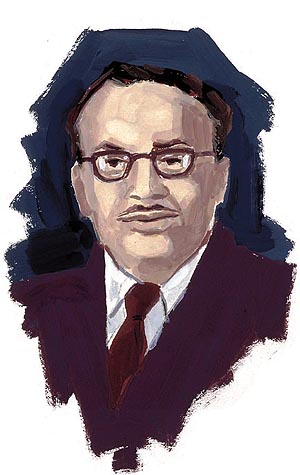WHILE the revolutionaries were trying to liberate Indians from the foreign yoke, there were others like Professor Meghnad Saha who sought to liberate the Indian mind itself from its self-imposed bondage. "The lethargy and dependence on others," he often observed, "which have become a part of our national character must be replaced by self-reliance and hard work. That is the only way out for us. The youth of this country should set their heart to remove poverty, take over industry, commerce, and other ways of independent livelihood from the clutches of foreigners and get ready to participate in the future task of making the most of our natural resources, large-scale preparation for which is already on. This is a challenge which calls for lifelong struggle and the first thing to be discarded is 'dependence on fate' "
 Saha's list of achievements is rather long. Besides being an outstanding scientist, he was also a great planner and administrator. He was instrumental in establishing the Uttar Pradesh Academy of Science, now known as the National Academy of Science, at Allahabad in 1930. It was on his recommendation that the National Institute of Science, now called the Indian National Science Academy, was established in New Delhi, in 1935. He also founded the Indian Science News Association, started publishing the journal Science & Culture, and contributed more than a hundred articles on national planning, flood and famine control, atomic physics, calendar reform and archaeology. As a result the Institute of Hydraulics and River Research of Bengal was established in 1942. The ambitious Damodar Valley Authority was also his brainchild.
Saha's list of achievements is rather long. Besides being an outstanding scientist, he was also a great planner and administrator. He was instrumental in establishing the Uttar Pradesh Academy of Science, now known as the National Academy of Science, at Allahabad in 1930. It was on his recommendation that the National Institute of Science, now called the Indian National Science Academy, was established in New Delhi, in 1935. He also founded the Indian Science News Association, started publishing the journal Science & Culture, and contributed more than a hundred articles on national planning, flood and famine control, atomic physics, calendar reform and archaeology. As a result the Institute of Hydraulics and River Research of Bengal was established in 1942. The ambitious Damodar Valley Authority was also his brainchild.
Although he gained fame as a physicist in school, it was mathematics that attracted him most. In middle school examinations he stood first, winning for himself a scholarship for further education. In the entrance examination, he stood first in the entire East Bengal. In 1909, he joined Dacca College, where he took to learning German, and in 1911 moved to Presidency College, Calcutta, for further studies. At Presidency College, he had J. C. Bose, and P. C. Ray as teachers, and for friends he had Subhas Chandra Bose, Satyendra Nath Bose, and P. C. Mahalanobis. With such intellectuals as competitors in the B. Sc. and M. Sc. examinations, young Meghnad stood second — the first position was secured by his friend Satyendra Nath Bose!
In college Meghnad Saha got involved in revolutionary activities, and as a result he had to forego his scholarship. After graduation he gave private lessons to some of his pupils and earned a living. Fortunately for him, Sir Asutosh Mukherjee, the Vice-Chancellor of Calcutta University, offered him a job in the Mathematics Department. Later Saha got himself transferred to the Physics Department and there with meagre facilities, he built a highly sensitive instrument to measure the pressure exerted by light. For this work he was awarded the D. Sc. degree of Calcutta University. By that time he was only 25.
Meanwhile, Saha was drawn towards astronomy after reading Agnes Clarke. He studied all the spectra of the sun and stars which had speared in various journals in the last 25 years, and mathematically linked atoms to conditions existing in the atmosphere and the interior of the sun and the stars.
During his visit to Germany, he came in contact with nuclear scientists like Otto Hahn, Fritz Strassman and Lise Meithner. He realised the potential of nuclear energy, and decided to set up such a programme in India. He came back and introduced nuclear physics as a subject in Calcutta University. However, his plans could not bear fruit because of World War II , and it was only in 1950 that he could go ahead with his plans at the then newly established Institute of Nuclear Physics, now renamed the Saha Institute of Nuclear Physics.
It is amazing that this former mathematician not only ushered in the nuclear programme in India, but also devoted his energies to biophysics by installing the country's first electron microscope.
No comments:
Post a Comment